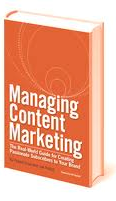 How do you attract passionate customers?
How do you attract passionate customers?
What can you do to cut through the noise and get people to notice what you have to say?
The answer is CONTENT—interesting and compelling information that helps solve your customers' problems.
Why Content?
It's interesting content that drives people to push that Share button or say to themselves, “Wow! This is a great article! I think I'll subscribe.”
Here's an analogy: If a big-time investor invited you to pitch your business idea to him, how much effort would you make to impress him?
I'm guessing that you wouldn't dare show up without a compelling idea and a well-thought-out strategy. And yet most businesses do just that when it comes to social media marketing.
Given the opportunity to influence an online audience of potential customers, they simply show up without preparing a compelling message. No wonder they don't see the results they want with their social media campaigns.
Prepare Your Message
Social media rewards interesting ideas. What is your audience most interested in? Find out what that is and then create compelling stories that feed your audience and generate passionate followings.
In their book Managing Content Marketing—The Real-World Guide for Creating Passionate Subscribers to Your Brand, Joe Pulizzi and Robert Rose sum it up this way: “Content is what converts customers.”
Whether you call yourself a social media marketer, an Internet marketer or a traditional marketer, you should define the kind of content that interests your potential customers, develop it and then prepare for the conversion to take place.
This book shows you how to do that. Here's what you need to know about it.
Authors' Purpose

Robert Rose and Joe Pulizzi wrote Managing Content Marketing to provide the vital steps required to understand this thing called content marketing.
Let's face it—it's not easy to create compelling content day in, day out. In fact, without proper knowledge, it's practically impossible. But it can be done. It starts with understanding three fundamental things about yourself and your market space:
- Who YOU are—What's your story?
- Who THEY are—Your customers, and why they should care about your story.
- What CONTENT can you provide them to build loyalty?
Ultimately you want to develop a content marketing strategy that helps you:
Get World-Class Marketing Training — All Year Long!
Are you facing doubt, uncertainty, or overwhelm? The Social Media Marketing Society can help.
Each month, you’ll receive training from trusted marketing experts, covering everything from AI to organic social marketing. When you join, you’ll also get immediate access to:
- A library of 100+ marketing trainings
- A community of like-minded marketers
- Monthly online community meetups
- Relevant news and trends updates
- Create passionate subscribers to your brand;
- Continually engage them with great content from the first day you meet them throughout their entire life cycle.
What to Expect

This book is a reminder to all business owners and marketers that we are all storytellers, and we need to figure out how to develop stories that will win over our audiences.
At 173 pages (12 chapters) you can expect an outstanding guide for doing content marketing the right way.
Part 1 examines to WHOM you want to tell your story; WHAT story to tell; and WHERE to tell it. Part 2 shows you how to manage the strategy you've created in Part 1. Overall, the book digs deep and discusses the more robust processes behind content marketing.
Highlights
#1: Build a Business Case for Content Marketing
Content marketing is so new that it's hard to identify the “hard business benefits” associated with it. However, the whole idea of creating compelling content is to get customers and make money.
To develop your business case for content marketing, ask yourself these questions:
- What's your business goal? (What challenges are you trying to solve?)
- How big an opportunity is it? (What is the outcome if it works?)
- What's the business model? How are you going to make it work? What kind of content do you need to make it work? Who will create it?
- What's your differentiating value? How is your content marketing going to be different from other marketing efforts you have attempted in the past; e.g., PPC or SEO? Can you anticipate success where other efforts have failed?
- What's the risk if you fail?
#2: Develop Your Pillars of Content
What's your story? If you own an air-conditioning company, for example, your story is not “providing and repairing air-conditioning systems.” Your company's story should be “providing a comfortable home experience.” Once that story has been grasped, the content ideas can begin to flow.

As you brainstorm your own content ideas, think about these questions:

Discover Proven Marketing Strategies and Tips
Want to go even deeper with your marketing? Check out the Social Media Marketing Podcast! Publishing weekly since 2012, the Social Media Marketing Podcast helps you navigate the constantly changing marketing jungle, with expert interviews from marketing pros.
But don’t let the name fool you. This show is about a lot more than just social media marketing. With over 600 episodes and millions of downloads each year, this show has been a trusted source for marketers for well over a decade.
- What environment do you find yourself in currently? Who are your customers? Are they happy or frustrated? What kind of content will make them happy?
- What's that big, audacious goal that you have for your company? Is it to introduce a new product? What kind of experience will your new product provide to customers?
- What happens if you launch this new product and it fails? How will you address your story then?
- What about the frustrations you faced while developing the new product? Work that into your story and get the audience on your side.
- How will you respond to those who said it couldn't be done—the competition and the naysayers?
- Reach out to other bloggers and share your point of view with them, and ask them to share theirs.
- How will the story continue after the product is launched? Tell stories that will continue to provide thought leadership.
#3: Create Passionate Subscribers
Content generated by satisfied customers is the most powerful way to reach your content goals. Apple® is the quintessential example of this. They have no social media presence and they have no blog. But they have successfully built a passionate subscriber base that is willing to create fan sites, write, share and evangelize the Apple® brand.

Here's how you can you create passionate subscribers:
- Know your target audience—Never create content from the “inside out” (based on what you already have in your “library”). It may not be relevant. Instead think like a cable TV station and define a very specific audience. Then create content that will inspire them.
- Feel their pain—Let's say your customer base is 80% men and only 20% women, but your product is equally useful to both sexes. Clearly you're not attracting enough women. What kind of content could you put in place that would attract the women who are not currently drawn to your product? For example, P&G uses a blog called ManofTheHouse.com to attract dads and a separate blog called HomeMadeSimple.com to attract moms.
- Determine the opportunity—What would happen if you could write content that eases the pain of your target audience? (Hint: “cha-ching!”) This is where RETURN on investment comes in.
- So if the opportunity is big enough to justify spending your time and money, then pull it all together with a solid content marketing strategy.
#4: Case Study: What Happens When You DON'T Write Your Story?
If you don't write your own story, guess what will happen? It will be written for you.
P&G found this out in early 2010 when they introduced a new Pampers product that was hailed by many as the “iPod of baby care.” It was a redesigned diaper that was thinner and more absorbent than the previous design.
But instead of repackaging the new product, P&G put the new diaper in the old packaging and didn't communicate this to their customers. As a result, furious mommy bloggers and Facebook groups popped up all over the place calling for the company to bring back the old product.
What P&G didn't realize is that their subscribers, in the absence of a story, would go ahead and make up a story themselves. A successful content marketing strategy would have made the launch more successful.
#5: Case Study: What Happens When You DO Write Your Story?
If you do write your own story, then YOU remain in control and can influence what your customers think about you.
In August 2010, a flight attendant on JetBlue flight 1052 from Pittsburgh to New York got into a fight with a passenger and proceeded to have a “take this job and shove it” moment! Then he grabbed a beer from the plane's galley and slid down the emergency evacuation chute.
Over the next few hours, JetBlue's Facebook page lit up with a torrent of angry comments. But an opportunity was brewing. The next day, JetBlue posted a rather tongue-in-cheek blog post titled, “Sometimes the Weird News Is About Us.”
What happened over the next few days was very interesting.
Slowly, the sentiment about JetBlue began to turn around. There were hundreds of sympathetic comments on the blog post and soon bloggers and the press began to notice. They wrote about JetBlue's “comeback” and how they “survived the crisis.” Soon everything was back to normal.
Personal Impressions
A lot has been written about content marketing and there's always a risk that another book on the same topic is just “beating a dead horse.”
However, Managing Content Marketing is modern, thought-provoking and at times even risky. It doesn't deal with the basics (there are plenty of other books for that); rather, it focuses on helping you develop a structure for your storytelling enterprise. If you're serious about learning how content marketing works, you won't go too far without it.
Fair warning—there are a few bold ideas in this book, some of which made me a little skittish; for example, the ideas of budgeting for failure (page 30) and switching your story when the current one doesn't work are not appealing, but they're sometimes necessary.
In the end, the authors' execution of content marketing as a business strategy is brilliant, and you can't help but feel a little smarter for having digested it.
Social Media Examiner gives this book a 5-star rating.
Over to You
How are you using content to convert your audience into customers? Please share your ideas in the comments box below.
Image from iStockPhoto.
Attention Agency Owners, Brand Marketers, and Consultants

Introducing the Marketing Agency Show–our newest podcast designed to explore the struggles of agency marketers.
Join show host and agency owner, Brooke Sellas, as she interviews agency marketers and digs deep into their biggest challenges. Explore topics like navigating rough economic times, leveraging AI, service diversification, client acquisition, and much more.
Just pull up your favorite podcast app, search for Marketing Agency Show and start listening. Or click the button below for more information.

